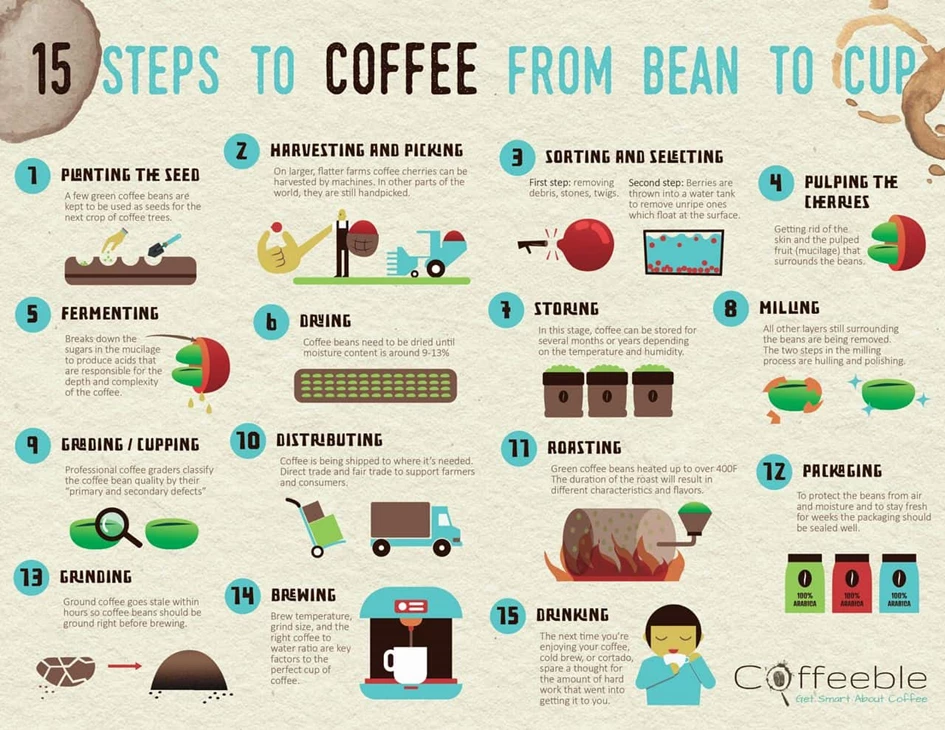How Coffee is Made?
Our friend, Thomas from Coffeeble.com, created this great infographic
If you read through this and decide you're ready to explore the fun and flavorful world of roasting, we have you covered with usually around 100 different varieties of green coffee beans! Enjoy!

15 Steps to Coffee From Bean to Cup – An infographic by Coffeeble
For many of us, the drink is one of those life necessities and splendors we just can’t live without. Some people cannot even picture starting their day without a nice warm cup.
Is Coffee a Fruit?
If you love coffee, have you ever stopped to wonder where does coffee come from? Many people imagine coffee beans growing on a plant but what they don’t know is that coffee doesn’t start in the form of a bean at all. A coffee bean is actually a seed that comes from a specific type of berries. Therefore, we can say that coffee beans actually come from a fruit!
Coffee berries usually contain beans that are split in two. However, in around 5% of the beans harvested it can happen that a bean doesn’t split and this type of a coffee bean is popularly called Peaberry since its shape resembles a pea.
How Coffee is Grown
When it comes to length of the whole production process, a coffee plant can take up to five years to produce its precious fruit and it cannot grow in every climate. In order to produce a good harvest, the coffee trees will require special care with the attention to soil. This limits where coffee is grown, but the climate where tree grows is typically a warm climate of subtropical regions and equatorial regions like Latin America, the Caribbean, or elsewhere.
Harvesting
The berries are typically harvested by a machine or picked by hand. In order to get the beans out, the fruit of the berry needs to be removed and after that the beans need to be processed. There are only two known ways of processing beans - dry processing, which is an older technique and wet processing, which is a more modern technique.
Coffee Processing Steps by Technique
Dry processing is the oldest method of coffee processing. The dry processed beans are placed in the sun and left to dry for around two weeks while being turned from time to time so they can dry evenly.
Wet processing is a modern method of processing beans and it takes place soon after the harvest. This coffee harvesting process consists of washing and fermentation. During this process the pulp that is left on the beans will become softer and the pulp be rinsed off. Today, this method of processing is used more frequently since it prevents damage to the beans.
When the processing is done, the beans are sorted. All of the bad beans are thrown out and the good ones are put in bags and shipped. At this point they are called “green coffee beans.” However, there is one final step, roasting the beans.
Roasting
The roasting process is essential and the final step in coffee production. It requires the perfect timing and setting of temperature to provide the perfect product. While the beans roast, they will split and their coating will be released.
How strong the coffee’s flavor is depends greatly on the bean roasting formula. For example, the longer the beans roast the more intense the flavor will be.
Ironically, it is assumed the stronger the flavor, the more caffeine. However it is actually the opposite which is true. The longer the coffee beans roast, the more the chemical, caffeine, is removed. You can buy your beans already roasted, but for the freshest experience, many people prefer to roast their own.
Keep in mind the name of a line of coffee beans, such as Breakfast Blend, can differ from one company to another. This is due because many use different roasting temperatures and times prepare a particular batch. Roasting beans even for a few minutes longer or shorter can alter the flavor of the entire batch.
Shipping, Grinding, and Brewing
Once the roasting is completed for a batch of beans the finished product is shipped to a retailer or sold directly to the consumer. Coffee beans are shipped all around the world from Africa to Italy or Canada and the United States or Mexico.
Everyone serves their coffee in various ways. While in the United States many people brew their coffee in coffee pots. Coffee is more than just the final brewing process. It is a lengthy process which starts as a simple coffee berry and eventually finds its final destination in the cups of coffee consumers all around the world.